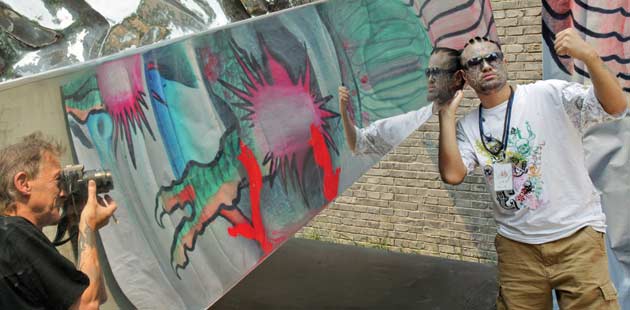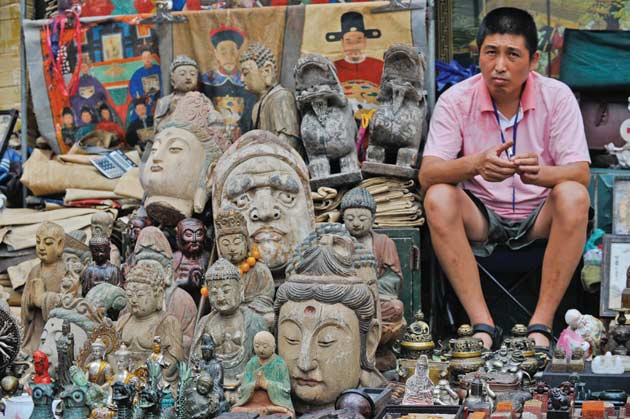Hidden Charms of Beijing
Updated: 2012-05-04 08:46
(China Daily)
|
|||||||||||
The charm of a great capital, such as Paris, Rome or London, reveals itself the moment you arrive. It is in your face, obvious for all to see. But to appreciate the essential character of Beijing, you may need to spend some more time. But in the long term, the effort is likely to prove more rewarding than the instant delights of Paris or Prague, and the unique experience is one you will want to revisit, physically or in memory. Call it the hidden magic of Beijing.
Last month, in "Beijing Blitz", we introduced a few less well-known places worth visiting in the historic city, such as the 798 Art Zone, Wudaoying hutong and Huguang Guild Hall.
Here are a few more hidden gems where you can soak up the charm of the ancient capital.
|
|
1. Caochangdi Art District
If the 798 Art Zone is to Beijing what Chelsea is to New York, then Caochangdi is like the Williamsburg neighborhood in Brooklyn.
Caochangdi, which means grasslands, is as its name suggests, a quieter, more idyllic pasture for Chinese modern artists, compared with the more commercialized 798 Art Zone.
This haven is located next to the Fifth Ring Road in the northeast of the city, and surrounded by a boisterous street life.
Caochangdi has attracted more than 300 other art bodies, including galleries, photographic studios and documentary filmmakers, with its cheaper rents and "purer" artistic atmosphere.
These art spaces are scattered among residents' houses, but stand out either through their avant-garde architecture or the various art forms of their creative interiors.
How to get there: Take a 418, 688 or 402 bus to Caochangdi station.
|
 Caochangdi Art District has attracted more than 300 art bodies.[Provided to China Daily] |
2. Panjiayuan Market
For those looking for an authentic shopping experience in China, Panjiayuan Market in the south of the capital would be a wise, discerning choice.
The covered outdoor market offers any type of Chinese craftwork and antique imaginable.
Exploring the rows of stalls and specialized sections, you stumble across antique paintings and calligraphy, jade jewelry, wooden and lacquered boxes, carved bone opium pipes, and many other relics from a bygone era, such as the Ming or Qing dynasties.
Of course, some are fake - like those you think you got for a bargain.
But whether you are a browser or buyer, you will probably find a treasure or two to take home. Hillary Clinton did. She bought two art pieces here.
The best part is that the sellers never yell at passers-by, so customers can enjoy leisurely browsing without the hassle and pressure of confrontational salesmanship.
The flea market is at its best on weekends, when thousands of sellers from all parts of China arrive with their local crafts and specialties.
Having a friend who speaks Mandarin certainly helps in bargaining for that Ming vase you fancy, but foreign tourists can calculate the risk for themselves just as easily on the vendor's (usually big-button and virtually antique) calculators.
How to get there: Take subway Line 10 and get off at Jinsong station.
3. Gaobeidian Antique Furniture Street
Museums and old palaces are not the only structures to display the city's splendid history. You can also find touches of the past among the thousands of pieces of antique furniture in the 1,000-year-old village of Gaobeidian, at the far end of East Chang'an Avenue.
It is a fascinating stroll down the main road of the village, with warehouses and showrooms lining either side. Reproductions of furniture from the Ming and Qing dynasties, with all their elegance, luster and intricate motifs, make Gaobeidian not only an nostalgic alternative to Ikea, but a virtual historic site in itself.
You will find a few time-honored stores overflowing with opium beds, benches, stools and drums, as well as antique decorations, refined porcelain and modern concept furniture made of old wood. A small piece can prove an excellent choice for an oriental collection or a souvenir of your visit to China.
How to get there: Get on subway line Batong and alight at Gaobeidian.
Dining and lodging
Though visitors to Beijing can choose cuisines from all parts of China, Beijing's own specialities are not to be missed. To sample them from snack stalls on the street takes more time and effort than dining in fine restaurants, but it is a more rewarding experience.
Snacks that have been popular for hundreds of years have obvious proven appeal and, you will discover, a unique taste. These include:
Wandouhuang, a kind of sweet and smooth pea-flour cake, was considered a royal dessert during the Qing Dynasty (1644-1911).
Ludagun, which means "donkey-rolling roll", is a Middle Eastern-style sweet snack, made from steamed glutinous millet or sticky rice, scattered with fried bean-flour, and filled with red pea. It has nothing to do with donkeys, you will be pleased to know.
Jiaoquan is an irresistibly crisp fried bread circle with salt, alkali and alum and is a breakfast favorite with local people.
These Beijing delicacies can be found night and day on the snack streets of Longfusi, Wangfujing and Shichahai.
If you do not want to stay in a big chain hotel with hundreds of other tourists, there are small boutique hotels that offer a cultural taste of the country.
The Shadow Puppet Hotel is up-front about what it offers in the way of graceful folk art to its guests. And all 10 rooms at the Padauk Hotel are furnished and decorated in valuable carved Padauk timber.
Both hotels are in the Shichahai area.
Today's Top News
Rescuers race against time for quake victims
Telecom workers restore links
Coal mine blast kills 18 in Jilin
Intl scholarship puts China on the map
More bird flu patients discharged
Gold loses sheen, but still a safe bet
US 'turns blind eye to human rights'
Telecom workers restore links
Hot Topics
Lunar probe , China growth forecasts, Emission rules get tougher, China seen through 'colored lens', International board,
Editor's Picks

|

|

|

|

|

|






